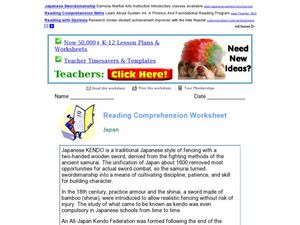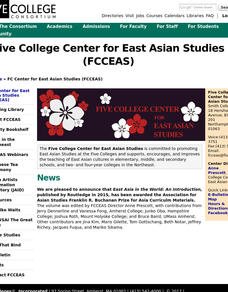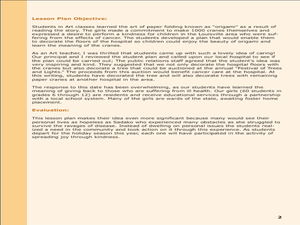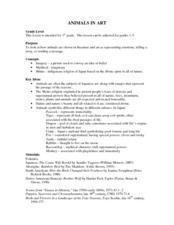Curated OER
Being in the Noh: An Introduction to Japanese Noh Plays
High schoolers read a Japanese Noh play and discuss its structure and traditional characters. They choose a short myth and write a Noh play based on it.
Curated OER
Haiku and Beyond: Exploring Genres of Japanese Literature
Fourth graders compare and contrast the literature of Japan as they study the culture, history and geography of the island nation. They read various genres of literature, describe geographic and landform features of Japan, and find...
Curated OER
Haiku - Poetry of the Samurai Warrior
Young scholars research the Samurai and their Haiku Writings. Students use internet research to gather information about the ancient Japanese Samurai. The young scholars then create individual Haiku writings, and a cultural day is...
Curated OER
GREEK MYTH IN PAINTING
Second graders look closely at a Renaissance painting depicting an ancient Greek myth, review the term renaissance, hear a Greek myth that tells how the peacock got its tail, sequence the story, and identify the actions of the myth in...
Curated OER
Being in the Noh: An Introduction to Japanese Noh Plays
Students analyze the conventions used in Noh plays and write an introduction to a Noh play of their own. In this Noh play lesson, students identify the conventions of the Noh form and analyze the realizations the main character achieves....
Curated OER
Reading Comprehension: Japan
In this reading for comprehension worksheet, students read a passage about Japanese Kendo and write answers using complete sentences. Students write 3 answers.
Curated OER
Judging a Book by Its Cover
Learners explore the relationship between the form of books and the content inside. For this book exploration lesson, students use a piece of their creative writing as inspiration; they author a written book and design a cover that...
Curated OER
Vaulting Into Olympic History
Students explore history of the Olympics. They research and then create an 'Olympics Hall of Fame' for the classroom.
Curated OER
Exploring & Creating Mythology
Young scholars read and compare mythological stories from ancient cultures from around the world. In small groups they read a myth and present the storyline and themes to the class, and write an original mythological story of their own...
Curated OER
Science in History Part I: the Abacus To the Modern Computer
In this math information worksheet, students read one page factual accounts of the early math inventions of the abacus, the calculator and early computers. There are 40 questions to answer about the reading.
Curated OER
A Journey To Japan Through Poetry
Third graders gain an appreciation for writing, analyzing, reading and listening to poetry, viewing poems as a motivation for studying Japanese culture and tradition. They study and create their own haiku and tanka poems with illustrations.
Curated OER
Two Haiku
Eighth graders, in pairs, discuss what they already know about Haiku poetry. They try to remember the rules, history, and focus of traditional Japanese Haiku. they read more examples of Haiku and then write and illustrate their own...
Curated OER
"For The Birds" [part II]
Students examine how Chinese and Japanese artists used different kinds of birds
as representations of ideas that were important in both cultures and create their own birds using the technique of origami.
Curated OER
Nature and Haiku Poetry
Students compose haiku poems and recognize how cultures value nature and
natural forces through the study of Japanese poetry. This instructional activity includes a bibliography of resources.
Curated OER
Writing & Language
Pupils examine Chinese and East Asian writing characters. They discuss how their writing systems differ from others found in the world. They practice reading and pronouncing Chinese and Japanese names and words.
Curated OER
Haiku
Young scholars study various forms of poetry and the culture of Japan. They are introduced to a haiku- a traditional form of poetry and an art form in the Japanese culture. They write a haiku and create a student haiku booklet with the...
Curated OER
Teaching the Hindu-Buddhist Tradition in East Asian Culture Through Asian Literature and Film
Students explore various intellectual traditions which dominate human history through a variety of contemporary pieces of literature which exemplify the traditions. Biblical monotheism, Greek rationalism, Hinduism, Buddhism, Confucianism...
Curated OER
Language Arts: Conversing with an Object
Students sharpen their creative writing skills by writing dialogues with unfamiliar objects while visiting local museums. They select an object in the museum, such as a painting, and create conversations between the people or animals...
Curated OER
Poetry In Motion
Fourth graders read and analyze poetry and examine the process of writing poetry. They read and analyze the poem "From a Railway Carriage" by Robert Louis Stevenson, and answer comprehension questions. They identify the similes,...
Curated OER
World Theatre Day
In this World Theatre Day instructional activity, students complete activities such as reading a passage, matching phrases, fill in the blanks, choose the correct word, multiple choice, unscramble the words, sequencing, unscramble the...
Curated OER
Origami Paper Cranes
Students complete cross-curricular activities to study the culture and humanity in Japan. Students read the book Sadako and the 1000 Paper Cranes and complete social studies and art lessons related to the book as well as develop an...
Curated OER
Journey, Travel and Trip Exercise
In this journey, travel, and trip activity, students fill in the blanks to the sentences with either the words journey, travel, or trip. Students complete 17 sentences and write 4 on their own.
Curated OER
Florida Comprehensive Assessment Test- 4th Grade Reading
For this reading worksheet, students prepare for the Florida Comprehensive Assessment test in 4th grade reading by completing this 15 page sample test.
Curated OER
Animals in Art
Students look at how animals are shown in literature and art as representing emotions, telling a story, or sending a message in this elementary school Language Arts and Visual Arts lesson.












!["For The Birds" [part II] Lesson Plan "For The Birds" [part II] Lesson Plan](http://content.lessonplanet.com/resources/thumbnails/122476/large/cgrmlwnvbnzlcnqymdeymtaxny0yoda5lwu0ew85zi5qcgc.jpg?1414222640)










